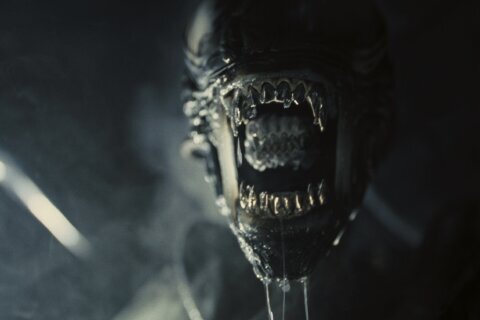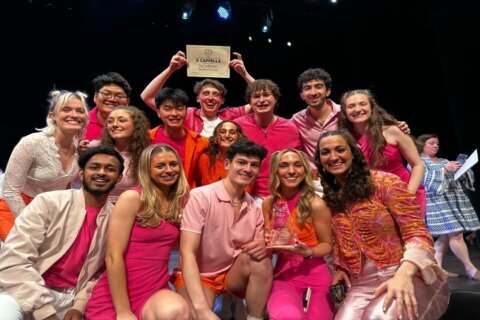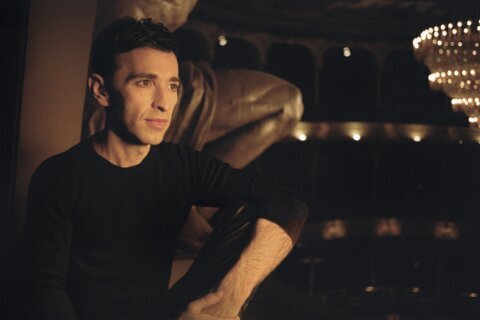Once a decade, Sight & Sound Magazine reveals its global critics poll of The Greatest Films of All Time. In 1952, the inaugural list was topped by Vittorio De Sica’s “Bicycle Thieves” (1948), while Orson Welles’ “Citizen Kane” (1941) reigned in 1962, 1972, 1982, 1992 and 2002 before Alfred Hitchcock’s “Vertigo” (1958) finally dethroned it in 2012.
On Thursday, the magazine released its latest poll of 1,639 critics, programmers, curators, archivists and academics, who crowned a new champion, one that many WTOP listeners probably haven’t seen: the Belgian-French flick “Jeanne Dielman, 23, quai du Commerce, 1080 Bruxelles” (1975) directed by the pivotal feminist filmmaker Chantal Akerman.
The film follows a lonely widow doing her daily chores, taking care of her teenage son and turning tricks for money. At three hours and 22 minutes, it won’t be everyone’s cup of tea, but like “Kane” and “Vertigo” before it, its newly anointed throne invites viewers to discover a new way of seeing cinema on a deeper academic level than popcorn entertainment.
Keep in mind, Sight & Sound’s picks aren’t bastions of Hollywood glory (check out the AFI Top 100), nor are they meant to be watched only once for escapism (try the IMDB Top 250). These films are meant to be analyzed like paintings over multiple viewings, revealing more symbolic images, camera angles and thematic layers on each repeat experience.
Here’s the Top 100 list, followed by what I think voters got right and wrong:
Sight & Sound Critics Poll of the Top 100 Greatest Films
1. “Jeanne Dielman, 23, quai du Commerce, 1080 Bruxelles” (Chantal Akerman, 1975)
2. “Vertigo” (Alfred Hitchcock, 1958)
3. “Citizen Kane” (Orson Welles, 1941)
4. “Tokyo Story” (Ozu Yasujiro, 1953)
5. “In the Mood for Love, Wong Kar-wai, 2000)
6. “2001: A Space Odyssey” (Stanley Kubrick, 1968)
7. “Beau travail” (Claire Denis, 1999)
8. “Mulholland Drive” (David Lynch, 2001)
9. “Man with a Movie Camera” (Dziga Vertov, 1929)
10. “Singin’ in the Rain” (Stanley Donen and Gene Kelly, 1952)
11. “Sunrise: A Song of Two Humans” (F.W. Murnau, 1927)
12. “The Godfather” (Francis Ford Coppola, 1972)
13. “La Règle du Jeu” (Jean Renoir, 1939)
14. “Cléo from 5 to 7” (Agnès Varda, 1962)
15. “The Searchers” (John Ford, 1956)
16. “Meshes of the Afternoon” (Maya Deren and Alexander Hammid, 1943)
17. “Close-Up” (Abbas Kiarostami, 1990)
18. “Persona” (Ingmar Bergman, 1966)
19. “Apocalypse Now” (Francis Ford Coppola, 1979)
20. “Seven Samurai” (Akira Kurosawa, 1954)
21. (TIE) “The Passion of Joan of Arc” (Carl Theodor Dreyer, 1928)
21. (TIE) “Late Spring” (Ozu Yasujiro, 1949)
23. “Playtime” (Jacques Tati, 1967)
24. “Do the Right Thing” (Spike Lee, 1989)
25. (TIE) “Au Hasard Balthazar” (Robert Bresson, 1966)
25. (TIE) “The Night of the Hunter” (Charles Laughton, 1955)
27. “Shoah” (Claude Lanzmann, 1985)
28. “Daisies” (Věra Chytilová, 1966)
29. “Taxi Driver” (Martin Scorsese, 1976)
30. “Portrait of a Lady on Fire” (Céline Sciamma, 2019)
31. (TIE) “Mirror” (Andrei Tarkovsky, 1975)
31. (TIE) “8½” (Federico Fellini, 1963)
31. (TIE) “Psycho” (Alfred Hitchcock, 1960)
34. “L’Atalante” (Jean Vigo, 1934)
35. “Pather Panchali” (Satyajit Ray, 1955)
36. (TIE) “City Lights” (Charlie Chaplin, 1931)
36. (TIE) “M” (Fritz Lang, 1931)
38. (TIE) “À bout de souffle” (Jean-Luc Godard, 1960)
38. (TIE) “Some Like It Hot” (Billy Wilder, 1959)
38. (TIE) “Rear Window” (Alfred Hitchcock, 1954)
41. (TIE) “Bicycle Thieves” (Vittorio De Sica, 1948)
41. (TIE) “Rashomon” (Akira Kurosawa, 1950)
43. (TIE) “Stalker” (Andrei Tarkovsky, 1979)
43. (TIE) “Killer of Sheep” (Charles Burnett, 1977)
45. (TIE) “North by Northwest” (Alfred Hitchcock, 1959)
45. (TIE) “The Battle of Algiers” (Gillo Pontecorvo, 1966)
45. (TIE) “Barry Lyndon” (Stanley Kubrick, 1975)
48. (TIE) “Wanda” (Barbara Loden, 1970)
48. (TIE) “Ordet” (Carl Theodor Dreyer, 1955)
50. (TIE) “The 400 Blows” (François Truffaut, 1959)
50. (TIE) “The Piano” (Jane Campion, 1992)
52. (TIE) “News from Home” (Chantal Akerman, 1976)
52. (TIE) “Fear Eats the Soul” (Rainer Werner Fassbinder, 1974)
54. (TIE) “The Apartment” (Billy Wilder, 1960)
54. (TIE) “Battleship Potemkin” (Sergei Eisenstein, 1925)
54. (TIE) “Sherlock Jr.” (Buster Keaton, 1924)
54. (TIE) “Le Mépris” (Jean-Luc Godard 1963)
54. (TIE) “Blade Runner” (Ridley Scott 1982)
59. “Sans soleil” (Chris Marker 1982)
60. (TIE) “Daughters of the Dust” (Julie Dash 1991)
60. (TIE) “La dolce vita” (Federico Fellini 1960)
60. (TIE) “Moonlight” (Barry Jenkins 2016)
63. (TIE) “Casablanca” (Michael Curtiz 1942)
63. (TIE) “GoodFellas” (Martin Scorsese 1990)
63. (TIE) “The Third Man” (Carol Reed 1949)
66. “Touki Bouki” (Djibril Diop Mambéty 1973)
67. (TIE) “The Gleaners and I” (Agnès Varda 2000)
67. (TIE) “Metropolis” (Fritz Lang 1927)
67. (TIE) “Andrei Rublev” (Andrei Tarkovsky 1966)
67. (TIE) “The Red Shoes” (Michael Powell & Emeric Pressburger 1948)
67. (TIE) “La Jetée” (Chris Marker 1962)
72. (TIE) “My Neighbour Totoro” (Miyazaki Hayao 1988)
72. (TIE) “Journey to Italy” (Roberto Rossellini 1954)
72. (TIE) “L’avventura” (Michelangelo Antonioni 1960)
75. (TIE) “Imitation of Life” (Douglas Sirk 1959)
75. (TIE) “Sansho the Bailiff” (Mizoguchi Kenji 1954)
75. (TIE) “Spirited Away” (Miyazaki Hayao 2001)
78. (TIE) “A Brighter Summer Day” (Edward Yang 1991)
78. (TIE) “Sátántangó” (Béla Tarr 1994)
78. (TIE) “Céline and Julie Go Boating” (Jacques Rivette 1974)
78. (TIE) “Modern Times” (Charlie Chaplin 1936)
78. (TIE) “Sunset Blvd.” (Billy Wilder 1950)
78. (TIE) “A Matter of Life and Death” (Michael Powell & Emeric Pressburger 1946)
84. (TIE) “Blue Velvet” (David Lynch 1986)
84. (TIE) “Pierrot le fou” (Jean-Luc Godard 1965)
84. (TIE) “Histoire (s) du cinéma” (Jean-Luc Godard 1988-1998)
84. (TIE) “The Spirit of the Beehive” (Victor Erice, 1973)
88. (TIE) “The Shining” (Stanley Kubrick, 1980)
88. (TIE) “Chungking Express” (Wong Kar Wai, 1994)
90. (TIE) “Madame de …” (Max Ophüls, 1953)
90. (TIE) “The Leopard” (Luchino Visconti, 1962)
90. (TIE) “Ugetsu” (Mizoguchi Kenji, 1953)
90. (TIE) “Parasite” (Bong Joon Ho, 2019)
90. (TIE) “Yi Yi” (Edward Yang, 1999)
95. (TIE) “A Man Escaped” (Robert Bresson, 1956)
95. (TIE) “The General” (Buster Keaton, 1926)
95. (TIE) “Once upon a Time in the West” (Sergio Leone, 1968)
95. (TIE) “Get Out” (Jordan Peele, 2017)
95. (TIE) “Black Girl” (Ousmane Sembène, 1965)
95. (TIE) “Tropical Malady” (Apichatpong Weerasethakul, 2004)
There are so many things that make me cheer (and cringe) about this list. Where should we start? Let’s move backwards in time through the different eras of movie history.
First, I’m thrilled that 21st century films cracked the list: Jordan Peele’s “Get Out” (2017) at No. 95, Bong Joon-ho’s “Parasite” (2019) at No. 90, Barry Jenkins’ “Moonlight” (2016) at No. 60, Celine Sciamma’s “Portrait of a Lady on Fire” (2019) at No. 30, David Lynch’s “Mulholland Drive” (2001) at No. 8, Wong Kar-wai’s “In the Mood for Love” (2000) at No. 5.
These picks aren’t a case of recency bias; they are beautifully crafted films with thrilling social statements on class (“Parasite”), racial commentary with double-meaning dialogue and symbolic visuals (“Get Out”), poetic imagery of coming-of-age identity (“Moonlight”) and some of the most sensual cinematography you’ll ever see (“In the Mood for Love”).
While these are all modern masterpieces deserving this distinction, it’s also a statement by global critics against popular fare. You won’t find any superhero flicks (Christopher Nolan’s “The Dark Knight”), fantasy franchises (Peter Jackson’s “The Lord of the Rings”) or blockbuster CGI wizards like George Lucas (“Star Wars”) and James Cameron (“Titanic”).
Oddly shut out are auteurs like Quentin Tarantino (“Pulp Fiction”), Coens (“Fargo”), David Fincher (“Se7en”), P.T. Anderson (“There Will Be Blood”), Wes Anderson (“The Royal Tenenbaums”), Ang Lee (“Brokeback Mountain”), Michael Haneke (“Cache”), Danny Boyle (“Trainspotting”), Darren Aronofsky (“The Wrestler”) and Kelly Reichardt (“First Cow”).
There’s a disappointing bias against modern Latin filmmakers like Pedro Almodovar (“All About My Mother”), Alfonso Cuarón (“Y Tu Mama Tambien”), Guillermo del Toro (“Pan’s Labyrinth”) and Alejandro González Iñárritu (“Birdman”), who all made history by winning recently at the Academy Awards, but find no such inclusion here.
Most notably, the list doesn’t include a single Steven Spielberg film, which means voters value the eye over the heart. Perhaps “Jaws” (1975), “Raiders of the Lost Ark” (1981), “E.T. the Extra-Terrestrial” (1982) and “Jurassic Park” (1993) were too mainstream, but surely “Schindler’s List” (1993) or “Saving Private Ryan” (1998) deserved consideration.
Alas, voters hated the blockbuster ’80s, opting for Stanley Kubrick’s “The Shining” (1980) at No. 88, David Lynch’s “Blue Velvet” (1986) at No. 84, Ridley Scott’s “Blade Runner” (1982) at No. 54 and Spike Lee’s “Do the Right Thing” (1989) at No. 24. I wasn’t expecting Gen X favorites like “Back to the Future” (1985) but where the hell is “Paris Texas” (1984)?
Comparatively, the Hollywood Renaissance of the ’70s fared slightly better with Francis Ford Coppola’s “The Godfather” (1972) at No. 12 and “Apocalypse Now” (1979) at No. 15. Martin Scorsese’s “Taxi Driver” (1976) is a worthy No. 29 to go with “Goodfellas” (1990) at No. 63, but no “Raging Bull” (1980) is an epic whiff for the best-edited film ever.
Voters ripped “Easy Riders, Raging Bulls” cover to cover. Even if you don’t share my love of “Rocky” (1976), this era had mise-en-scene by Arthur Penn (“Bonnie & Clyde”), Mike Nichols (“The Graduate”), John Schlesinger (“Midnight Cowboy”), Sam Peckinpah (“The Wild Bunch”), Robert Altman (“Nashville”) and Sidney Lumet (“Network”), but none made it!
Instead, voters hailed the French New Wave masters who inspired them. Jean-Luc Godard has “Breathless” (1960) at No. 38, “Contempt” (1963) at No. 54 and “Pierrot le Fou” (1965) at No. 84. Francois Truffaut has “The 400 Blows” (1959) at No. 50, but no “Jules and Jim” (1962) or “Day for Night” (1973). Alain Resnais’ “Hiroshima Mon Amour” (1959) is a snub.
Their Italian peers landed Sergio Leone’s “Once Upon a Time in the West” (1968) at No. 95, Luchino Visconti’s “The Leopard” (1963) at No. 90 and Michelangelo Antonioni’s “L’Avventura” (1960) at No. 72. Federico Fellini’s “La Dolce Vita” (1960) and “8 1/2” (1963) are too low at No. 60 and No. 31. Where’s Bernardo Bertolucci’s “The Conformist” (1970)?
#MeToo fallout canned Poland’s Roman Polanski, though “Knife in the Water” (1962), “Repulsion” (1965), “Rosemary’s Baby” (1968) and “Chinatown” (1974) rival any movie on this list. Same with Woody Allen’s “Annie Hall” (1977), “Manhattan” (1979), “Purple Rose of Cairo” (1985), “Hannah and Her Sisters” (1986) and “Crimes and Misdemeanors” (1989).
Allen’s idol, Sweden’s Ingmar Bergman, deserved more than “Persona” (1966) at No. 18 with snubs of “The Seventh Seal” (1957) and “Wild Strawberries” (1957). Thankfully, Germany’s Max Ophuls has “Madam De” (1953) at No. 90, while France’s Robert Bresson has “Au Hasard Balthazar” (1966) and “A Man Escaped” (1956) at No. 25 and No 95.
Mid-century Asian cinema had a strong showing. Japanese legend Akira Kurosawa landed two with “The Seven Samurai” (1954) at No. 20 and “Rashomon” (1950) at No. 41 but sadly no “Ikiru” (1952), Yasujiro Ozu scored two with “Tokyo Story” (1953) at No. 4 and “Late Spring” (1949) at No. 21, and Kenji Mizoguchi’s “Ugetsu” (1953) came in at No. 90.
As for the war-torn 1940s, Italian Neorealist Vittorio De Sica has “Bicycle Thieves” (1948) at No. 41 instead of “Umberto D” (1952); Roberto Rossellini’s “Rome Open City” (1945) was snubbed in favor of “Journey to Italy” (1954) at No. 72; and French master Jean Renoir has “The Rules of the Game” (1939) at No. 13 but no “La Grand Illusion” (1937).
Voters also hailed post-war British classics like Carol Reed’s noir masterpiece “The Third Man” (1949) at No. 63 and Michael Powell and Emeric Pressburger’s “The Red Shoes” (1948) and “A Matter of Life and Death” (1946) at No. 67 and No. 78, but the lack of “The Life and Death of Colonel Blimp” (1943) will surely have critics scratching their heads.
Speaking of British masters, where on earth is the iconic David Lean? Did voters punish “The Bridge on the River Kwai” (1957), “Lawrence of Arabia” (1962) and “Doctor Zhivago” (1965) for crossover U.S. appeal? Perceived colonialism? Swelling music? Lean is the epitome of epic filmmaking, but also small-scale gems like “Brief Encounter” (1945).
In Hollywood’s Golden Age, Alfred Hitchcock rules with four entires: “Vertigo” (1958) at No. 2, “Psycho” (1960) at No. 31, “Rear Window” (1954) at No. 38 and “North By Northwest” (1959) at No. 45. Of course, “Notorious” (1946) is better than just about every movie on this list, not to mention pop-horror like “The Birds” (1963) that is deeper than you think.
Billy Wilder lands three masterpieces: “Some Like It Hot” (1959) at No. 38, “The Apartment” (1960) at No. 54 and “Sunset Blvd” (1950) at No. 78, though I miss “Double Indemnity” (1944). John Ford deserves more than just “The Searchers” (1956) at No. 15 with “Stagecoach” (1939), “The Grapes of Wrath” (1940) and “Liberty Valance” (1962).
Michael Curtiz’s “Casablanca” (1942) is low at No. 63 with zero films by George Stevens (“Giant”), John Huston (“The Maltese Falcon”), Nicholas Ray (“Rebel Without a Cause”), Elia Kazan (“On the Waterfront”), George Cukor (“The Philadelphia Story”), Frank Capra (“It’s a Wonderful Life”), Howard Hawks (“Rio Bravo”) or William Wyler (“Ben-Hur”).
For all the genius mise-en-scene in Douglas Sirk’s “Imitation of Life” (1959) at No. 75 or Charles Laughton’s “The Night of the Hunter” (1955) at No. 25, I can point to just as much in “Giant” (1956) or “It’s a Wonderful Life” (1946). Also, “All About Eve” (1950) has a better script than most of these picks, while “King Kong” (1933) eats these movies for breakfast.
The Technicolor musicals really suffered. While “Singin’ in the Rain” (1952) made the Top 10, voters axed Vincente Minnelli (“Meet Me in St. Louis,” “An American in Paris”) and Robert Wise (“West Side Story,” “The Sound of Music”). Even if you think “Gone With the Wind” (1939) is problematic, Victor Fleming deserved a spot for “The Wizard of Oz” (1939).
Classic Hollywood comedies got the shaft. The Marx Brothers and Laurel & Hardy are too lowbrow for these voters, as are screwball gems like Capra’s “It Happened One Night” (1934), Hawks’ “Bringing Up Baby” (1938) and “His Girl Friday” (1940), Preston Sturges’ “Sullivan’s Travels” (1941) and Ernst Lubitsch’s “The Shop Around the Corner” (1940).
Silent comedies fared better with Buster Keaton’s “Sherlock Jr.” (1924) and “The General” (1926) at No. 54 and No. 95 and Charlie Chaplin’s “City Lights” (1931) and “Modern Times” (1936) at No. 36 and No. 78. They paved the way for Jacques Tati’s “Playtime” (1967) at No. 23, so I’d rank the original Stoneface and Tramp over Monsieur Hulot’s homage.
Voters loved silent dramas like Dziga Vertov’s “Man with a Movie Camera” (1929) at No. 9, F.W. Murnau’s “Sunrise” (1927) at No. 11, Carl Theodor Dreyer’s “The Passion of Joan of Arc” (1927) at No. 21, Sergei Eisenstein’s “Battleship Potemkin” (1925) at No. 54 and Fritz Lang’s “Metropolis” (1927) at No. 67, while D.W. Griffith is now in the ash heap of history.
It’s a shame there’s no mention of Walt Disney, who pioneered the first sync-sound cartoon “Steamboat Willie” (1928). To not have any Disney (“Snow White,” “Pinocchio,” “Bambi”) is just as academically dishonest as a list that didn’t include Hayao Miyazaki, who thankfully has “My Neighbor Totoro” (1988) at No. 72 and “Spirited Away” (2001) at No. 75 here.
Maybe someday Pixar’s “Toy Story” (1995) or “WALL-E” (2008) will find a spot, but digital animation might be the toughest genre for global critics to agree upon. Same with horror (no “The Exorcist,” “Halloween” or “The Silence of the Lambs”) and comedy (Peter Sellers, Robin Williams and Eddie Murphy are nowhere to be found on this ultra-highbrow list).
Ballots lacked the guts to pick “Blazing Saddles” (1974), “Young Frankenstein” (1974), “Monty Python & The Holy Grail” (1975), “Animal House” (1978), “Airplane!” (1980), “Caddyshack” (1980), “Groundhog Day” (1993), “Austin Powers” (1997), “40-Year-Old Virgin” (2005), “Wedding Crashers” (2005), “Hangover” (2009) or “Bridesmaids” (2011).
Alas, it’s not that kind of list. Nor should it be, necessarily. We have other lists ranking the funniest comedies, the scariest movies and the most beloved animated films. For now, we’ll appreciate Sight & Sound for what it is: the cinephile’s counter to the popular vote.
At least female filmmakers have a spot at the table. In addition to the top slot, we also have Maya Deren’s “Meshes of the Afternoon” (1943) at No. 16, Agnes Varda’s “Cleo from 5 to 7” (1962) at No. 14, Barbara Loden’s “Wanda” (1970) at No. 48, Jane Campion’s “The Piano” (1993) at No. 50 and Julie Dash’s “Daughters of the Dust” (1991) at No. 60.
In the end, it’s impossible to make a list for everyone. If your favorite film is missing, check out Sight & Sound’s global Directors Poll, a completely separate list that was also released yesterday as a companion piece to the critics poll. Hint: Spielberg’s “Jaws” is on there. Stay tuned in the coming days as various directors reveal their individual Top 10 ballots.
If you’re just beginning your journey through film history, I suggest first diving into the American Film Institute’s Top 100 Movies. Once you’ve seen those, you can then expand your horizons to explore the masterpieces of world cinema hailed by Sight & Sound.








